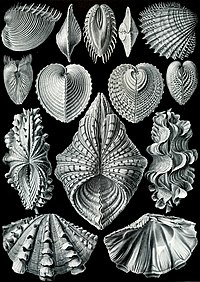
Photo from wikipedia
A novel biological approach using ark shell bivalves as potential species for remediation of effluents was studied to determine the microbial community interspecies interaction and nutrient cycling in a restoration… Click to show full abstract
A novel biological approach using ark shell bivalves as potential species for remediation of effluents was studied to determine the microbial community interspecies interaction and nutrient cycling in a restoration system of mariculture effluents. A field study showed that Scapharca subcrenata was the main driver of the microbial community's interspecies-interaction (PERMANOVA, R = 0.0572, P = 0.005) in the treatment zone (TZ). Analysis of co-occurrence networks based on random matrix theory (RMT) indicated that the network's complexity parameters were enhanced in the TZ and disrupted in the control zone (CZ) due to eutrophic disturbances. Concurrently, the TZ was correlated with more profound network modifications (i.e., higher modularity, total nodes (n), cohesion, and proportion of positive links), suggesting that S. subcrenata influenced microbial interspecies interactions in the system. Similarly, the co-occurring networks of generalists Proteobacteria (OTU2037) at genus Anaerospora and Actinobacteria (OTU9660) at genus Candidatus aquiluna for anaerobic ammonia-oxidation (ANAMMOX) were highly significant in the TZ. The top-down and bottom-up forces of S. subcrenata influenced the removal efficiency of nitrogenous compounds by reducing 81.51% of nitrite (NO2--N), 84.61% of total ammonium nitrogen (TAN) and 72.78% of nitrate (NO3--N). Generally, the introduction of ark shell bivalve (S. subcrenata) to the system as a biofilter provides a very low-cost bioremediation technology that could be one of the best restorations and remediation tools for mariculture effluents.
Journal Title: Marine environmental research
Year Published: 2020
Link to full text (if available)
Share on Social Media: Sign Up to like & get
recommendations!